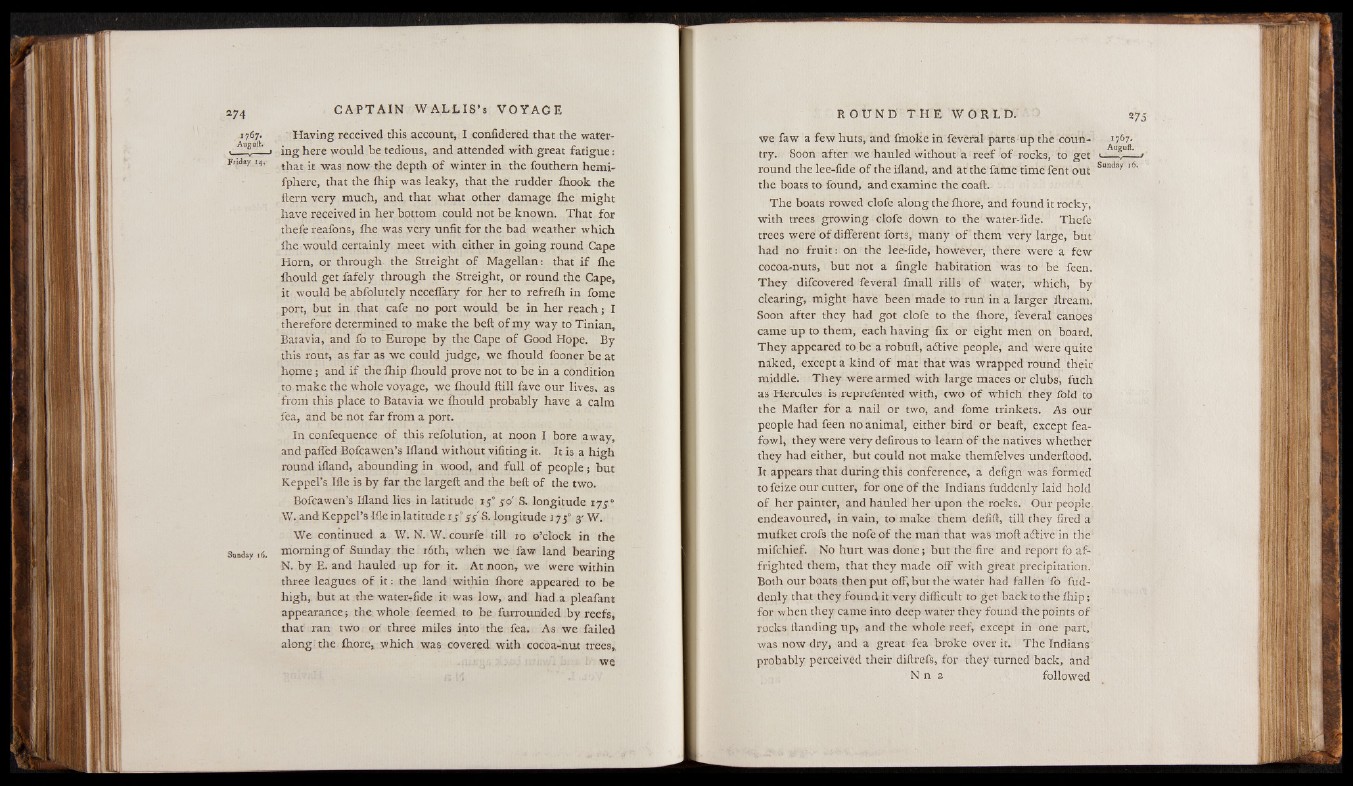
1767- ' Having received this account, I confidered that the water-
■ Au^u ' ■ ing here would be tedious, and attended with great fatigue :
■ ay ,‘1' that it was now the depth o f winter in the fouthern hemi-
fphere, that the fhip was leaky, that the rudder Ihook the
Hern very much, and that what other damage Ihe might
have received in her bottom could not be known. That for
thefe reafons, fh.e was very unfit for the bad weather which
Ihe would certainly meet with either in going round Cape
Horn, or through the Stieight o f Magellan: that i f Ihe
fhould get fafely through the Streight, or round the Cape,
it would be abfolutely neceffary for her to refrefli in fome
port, but in that cafe no port would be in her reach; I
therefore determined to make the beft of my way to Tinian,
Batavia, and fo to Europe by the Cape o f Good Hope. By
this rout, as far as we could judge, we Ihould fooner be at
home ; and i f the ihip Ihould prove not to be in a condition
to make the whole voyage, we Ihould Hill fave our lives, as
from this place to Batavia we Ihould probably have a calm
fea, and be not far from a port.
In confequence of this refolution, at noon I bore away,
and palled Bofcawen’s Bland without viliting it. It is a high
round ifland, abounding in wood, and full of people; but
Keppel’s Ille is by far the largeft and the beft o f the two.
Bofcawen’s Illand lies in latitude 15° 50' S. longitude 175°
W. and Keppel’s Me in latitude 15° 55' S. longitude 175° 3 'W.
We continued a W. N. W. courfe till 10 o’clock in the
Sunday ,6. morning o f Sunday the. 16th, when w e faw land bearing
N. by E. and hauled up for it. At noon, we were within
three leagues o f i t : the land within lhore appeared to be
high, but at the water-fide it was low, and had a pleafant
appearance; the whole feemed to be furrounded by reefs,
that ran two or three miles into the fea. As we failed
along the lhore, which was covered with cocoa-nut trees,
1 we
we faw a few huts, and fmoke in feveral parts up the coun- >76
try. Soon after we hauled without a reef o f rocks, to get ^
round the lee-fide of the illand, and at the fame time fent out Sanday
the boats to found, and examine the coaft.
The boats rowed clofe along the lhore, and found it rocky,
with trees growing clofe down to the water-fide. Thefe
trees were o f different forts, many o f' them very large, but
had no f ru it : on the lee-fide, however, there were a few
cocoa-nuts, but not a fingle habitation was to be feen.
They difcovered feveral fmall rills o f water, which, by
clearing, might have been made to run in a larger ftream.
Soon after they had got clofe to the lhore, feveral canoes
came up to them, each having fix or eight men on board.
They appeared to be a robuft, adtive people, and were quite
naked, except a kind o f mat that was wrapped round their
middle. They were armed with large maces or clubs, fuch
as Hercules is reprefented with, two o f which they fold to
the Mailer for a nail or two, and fome trinkets. As our
people had feen no animal, either bird or beaft, except fea-
fowl, they were very defirous to learn o f the natives whether
they had either, but could not make themfelves underftood.
It appears that during this conference, a defign was formed
to feize our cutter, for one o f the Indians fuddenly laid hold
o f her painter, and hauled her upon the rocks. Our people,
endeavoured, in vain, to make them defift, till they fired a
mulket crofs the nofeof the man that was moft adtive in the
mifchief. No hurt was done; but the fire and report fo affrighted
them, that they made off with great precipitation.
Both our boats then put off, but the water had fallen fo fuddenly
that they found it very difficult to get back to the Ihip;
for when they came into deep water they found the points o f
rocks Handing up, and the whole reef, except in one part,
was now dry, and a great fea broke over it. The Indians
probably perceived their diftrefs, for they turned back, and
N n 2 followed